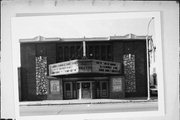| Additional Information: | In 1919-1920, Otto Bell constructed the Bell Theatre at 210 South Water Street. The Bell Theatre was continuously used as a movie house of some nature throughout the 1920's and 1930's. The Bell Theatre advertised that it was modern and fire proof. In the 1920's, it showed newsreels and a weekly variety of silent movies, featuring Rudolph Valentino, Clara Bow (the "It" girl), Lillian Gish, Harold Lloyd, and even Rin Tin Tin in a feature called "The Night Cry." Sound, introduced in 1927, greatly expanded film potentialities. By November, 1927, the Bell Theater changed its name to the Classic Theater, which began showing these sound movies. At this time, Dragnis, Burkitt and Peter Stathis ownered the theater. In 1945, Peter Stathis bought out his partners. Besides being a facility for films, the Bell Theatre also held local performances.
The Bell Theatre gains local historical significance under criterion A in association with the Motion Pictures topic of the Recreation and Entertainment Theme. The Bell Theatre was Sparta's first prominent motion picture theater to show sound movies in Sparta. The building's period of historical significance ranges from its erection and initial occupation in 1919-1920 to the closing of its last well-documented business prior to its closing.
Utilizing a structural system that combined brick construction with iron trusses, this one-story theater building displays a red brick facade topped by a projecting cornice with stylized arched pediments that correspond to the projecting brick bays at the ends of the facade. The brick facade is divided vertically by a two-story pair of slightly projecting brick pilasters at the ends of the facade and by a series of long blind stylized arches on the upper story between the pilasters [above the marque]. A brick panel in a geometric design is located at the top of the bay recessed between the pair of two-story pilasters. Decorative brick work also outlines the top of the facade as well as the base of the pilasters. The marque in the center of the lower story features a ticket booth flanked on both sides by sidelighted doors and display windows.
This theater building has been altered by the addition of stone veneer to the recessed panels on the facade between the brick pilasters. In addition, the marque has been remodeled.
Built on the site of an old frame livery station, this theater was constructed in 1919-1920. This building originally housed the Bell Theater, which later was renamed the Classic Theater. Built to accomodate motion picture, this theater originally was equiped with a stage, scenery, and an organ. A neworgan was installed in 1921.
The Bell Theater is significant under Criterion C as a well preserved examples of early 20th century movie theater and as an example of early modern design. Important as an example of early 20th century architecture in transition and as the best preserved theater building in the proposed Water Street Historic District, the Bell Theater has been altered only by the addition of stone panels to its facade. This theater, displaying the influence of the Classical Revival in an abstract manner, is a representative of the transition between the historic styles and the new modern styles designed without reference to the historic styles. |
|---|
| Bibliographic References: | (A) City of Sparta, WI, Tax Records, 1917-1930.
(B) Sanborn Insurance Maps 1884, 1889, 1894, 1900, 1911, 1922, 1931.
(C) Julia Middleman, Interview, Sparta, WI, June 6, 1990.
(D) Sparta Herald April 12, 1921.
(E) City of Sparta Property Tax Rolls, 1870-1940.
(F) Monroe County Democrat June 3, 1926; Nov. 3, 1927. |
|---|

